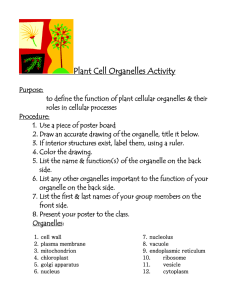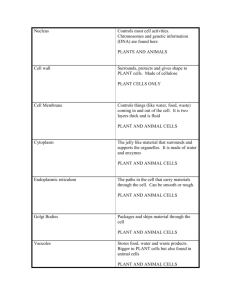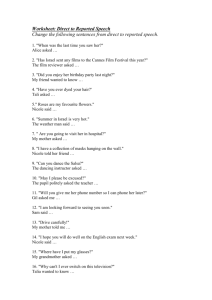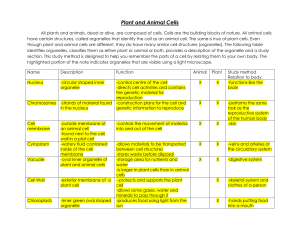Little Girl Lost: A Case Study on Defective Cellular Organelles
advertisement
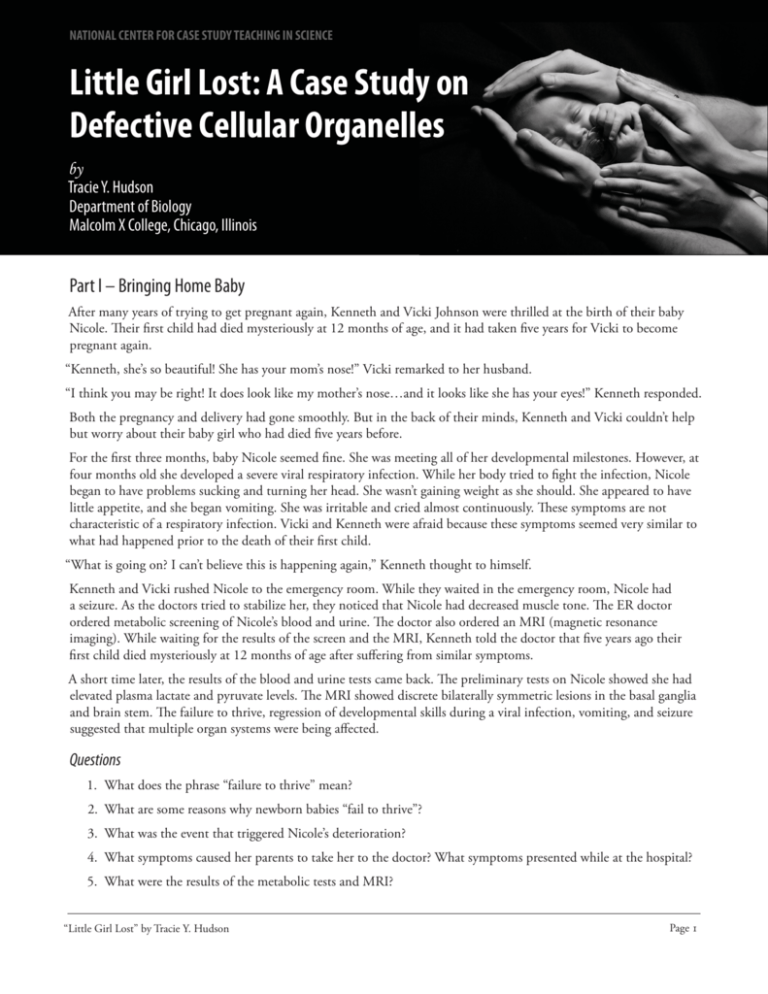
NATIONAL CENTER FOR CASE STUDY TEACHING IN SCIENCE Little Girl Lost: A Case Study on Defective Cellular Organelles by Tracie Y. Hudson Department of Biology Malcolm X College, Chicago, Illinois Part I – Bringing Home Baby After many years of trying to get pregnant again, Kenneth and Vicki Johnson were thrilled at the birth of their baby Nicole. Their first child had died mysteriously at 12 months of age, and it had taken five years for Vicki to become pregnant again. “Kenneth, she’s so beautiful! She has your mom’s nose!” Vicki remarked to her husband. “I think you may be right! It does look like my mother’s nose…and it looks like she has your eyes!” Kenneth responded. Both the pregnancy and delivery had gone smoothly. But in the back of their minds, Kenneth and Vicki couldn’t help but worry about their baby girl who had died five years before. For the first three months, baby Nicole seemed fine. She was meeting all of her developmental milestones. However, at four months old she developed a severe viral respiratory infection. While her body tried to fight the infection, Nicole began to have problems sucking and turning her head. She wasn’t gaining weight as she should. She appeared to have little appetite, and she began vomiting. She was irritable and cried almost continuously. These symptoms are not characteristic of a respiratory infection. Vicki and Kenneth were afraid because these symptoms seemed very similar to what had happened prior to the death of their first child. “What is going on? I can’t believe this is happening again,” Kenneth thought to himself. Kenneth and Vicki rushed Nicole to the emergency room. While they waited in the emergency room, Nicole had a seizure. As the doctors tried to stabilize her, they noticed that Nicole had decreased muscle tone. The ER doctor ordered metabolic screening of Nicole’s blood and urine. The doctor also ordered an MRI (magnetic resonance imaging). While waiting for the results of the screen and the MRI, Kenneth told the doctor that five years ago their first child died mysteriously at 12 months of age after suffering from similar symptoms. A short time later, the results of the blood and urine tests came back. The preliminary tests on Nicole showed she had elevated plasma lactate and pyruvate levels. The MRI showed discrete bilaterally symmetric lesions in the basal ganglia and brain stem. The failure to thrive, regression of developmental skills during a viral infection, vomiting, and seizure suggested that multiple organ systems were being affected. Questions 1. What does the phrase “failure to thrive” mean? 2. What are some reasons why newborn babies “fail to thrive”? 3. What was the event that triggered Nicole’s deterioration? 4. What symptoms caused her parents to take her to the doctor? What symptoms presented while at the hospital? 5. What were the results of the metabolic tests and MRI? “Little Girl Lost” by Tracie Y. Hudson Page 1 NATIONAL CENTER FOR CASE STUDY TEACHING IN SCIENCE Part II – The Diagnosis “Given the results of the metabolic screen, the multiple organ system involvement, and the telltale lesions in the brain, it appears that Nicole has Leigh Syndrome (LS),” reported the ER doctor. “Leigh syndrome is a severe neurological disorder that usually arises in the first year of life. It is characterized by the degeneration of the central nervous system. Its onset is typically triggered by a viral illness. This condition is characterized by progressive loss of mental and movement abilities and typically results in death within a couple of years, usually due to respiratory failure,” explained the doctor. The doctor continued: “Leigh Syndrome affects approximately one in 36,000 to 40,000 newborns. Most cases of Leigh Syndrome are associated with a nuclear mutation in the SURF1 gene. This leads to a defect in a protein found in cellular organelles responsible for energy production. Since these organelles are found in all cells, all organs of the body will be affected, especially organs like the brain, heart, and GI tract, which have high-energy needs. This syndrome can be inherited in different ways but is usually inherited as an autosomal recessive condition,” concluded the doctor. Unaffected "Carrier" Father Unaffected "Carrier" Mother r R R R R r r R R r r r The doctor then proceeded to explain how autosomal recessive conditions are inherited. “For an individual to be affected, he or she would need to inherit a defective nonworking copy from each parent. The individual would then be described as being homozygous recessive,” the doctor explained (see Figure 1). Kenneth and Vicki were dumbfounded. Not only were they faced with the prospect of losing another child, the idea that they were responsible for passing the defected gene to their child was almost too much to bear. They sat quietly as the doctor recommended that they undergo genetic testing as well as genetic counseling. Unaffected 1 in 4 chance Unaffected "Carrier" 2 in 4 chance Affected 1 in 4 chance Figure 1. Autosomal Recessive Inheritance. Source: Colin M.L. Burnett, https://commons.wikimedia.org/wiki/File:Autorecessive.svg, cc by-sa 3.0. Questions 1. What was Nicole’s diagnosis? What gene mutation is probably involved? 2. The mutation described above affects a protein commonly found in cellular organelles involved in energy production. What organelle would this most likely be? 3. How many people are born with Leigh Syndrome (LS)? 4. What is the expected lifespan for LS sufferers? 5. How is it that Vicki and Kenneth’s daughter could have inherited LS even though neither of her parents suffers from it? 6. What is the probability that they would have another affected child? What is the probability that they would have another child who is a carrier? 7. What is the probability of having a child that doesn’t have LS and is also a non-carrier for LS? “Little Girl Lost” by Tracie Y. Hudson Page 2 NATIONAL CENTER FOR CASE STUDY TEACHING IN SCIENCE Part III – Understanding the Cell Kenneth and Vicki were in a state of shock as they drove home. The doctor had said that Nicole’s disease was caused by a defective cellular organelle. However he hadn’t explained what an organelle was or which one was defective. Kenneth decided to do some research. “I need to better understand the source of Nicole’s illness ,” Kenneth said with resolve. He searched the Internet for information using the words “cellular organelle.” He found the following picture and information. Figure 2. Animal cell adapted from https://commons.wikimedia.org/wiki/File:Animal_Cell_Unannotated.svg, p.d. Features of Plant and Animal Cells: All living organisms are made of one or more cells. Cells contain organelles. Organelles are defined as a specialized subunit within a cell that has a specific function. The information below describes the various organelles found in cells along with their functions. Cells have a nucleus. The nucleus controls the cell’s activities. Also contained within the nucleus is the nucleolus. The nucleolus is used in the production of ribosomes. The nucleus also contains the chromatin. Chromatin is uncondensed DNA and serves as the blueprint for controlling the cell’s functions and for building more cells. Outside the nucleus is the cytoplasm. This aqueous material contains numerous other organelles. Ribosomes are found floating in the cytoplasm or attached to the endoplasmic reticulum (ER). They synthesize proteins. The ER is a series of interconnecting flattened tubular channels. The ER takes two forms: rough ER and smooth ER. The smooth ER plays a role in lipid synthesis. The rough ER has ribosomes attached and plays a role in protein synthesis, protein, and protein folding. Small vesicles containing newly synthesized protein separate from the ends of the rough ER. The vesicles are used to ship them to other parts of the cell or to the outside of the cell. They can also be shipped to the Golgi apparatus for further protein modification, sorting, and packaging. The Golgi apparatus is a stack of membranous flattened sacs and is directly associated with the endoplasmic reticulum. “Little Girl Lost” by Tracie Y. Hudson Page 3 NATIONAL CENTER FOR CASE STUDY TEACHING IN SCIENCE Additional organelles include small vacuoles, lysosomes, peroxisomes, and mitochondria. Small vacuoles are involved in storage. Lysosomes contain hydrolytic enzymes that are necessary for intercellular digestion of macromolecules. They also degrade worn out organelles. Products of their degradation can be reused. Peroxisomes are responsible for protecting the cell as they rid the body of toxic substances such as hydrogen peroxide. Peroxisomes also break down fat. Mitochondria are the sites of aerobic respiration, and generally are the major energy production center in cells. They produce ATP, the universal energy carrier of cells from organic molecules such as carbohydrates, proteins, and lipids. Cells have cytoskeletal components such as microtubules, actin, and intermediate filaments. These components play numerous roles in the cell such as support, structure, and movement. Microtubules are found in cilia (minute hair‐like organelles involved in movement of mucus out of the lungs and the egg in the fallopian tube), and flagella (similar to cilia but longer and typically found on sperm). Lastly, cells have a cell membrane. The thin membrane is essential in controlling exchange between the cell and its environment. It acts as a very efficient barrier, but also allows a controlled traffic of materials across it in both directions. The membrane is therefore considered as partially semi‐permeable. It allows some materials to pass but not others. “So an organelle is kind of like a miniature organ of the cell that does something special for the cell,” Kenneth said out loud. He then skimmed through the information again to find the “cellular organelles responsible for energy production” that the doctor referred to when explaining Nicole’s condition. “From the information I just read, the mitochondria is involved in energy production for the cell. So this must be the defective organelle that the doctor was referring to!” Kenneth exclaimed excitedly. “But how could this one tiny defective organelle cause the range of problems that Nicole has,” he wondered. Kenneth decided to do some more research. While researching, he found the following information. Understanding the Structure and Function of the Cell: In order to understand the organization of the cell and remember the various cellular organelles it might be useful to use an analogy. An analogy compares something new with something you already know. The known concept is the analog and the unknown concept is the target. A factory is often used as an analog for the cell. A factory converts raw materials to useful products much like the cell does. The factory has different components, offices, and staff persons that carry on different functions in order to make the product and keep the factory running smoothly. This is true of the cell as well in that it has different organelles performing different functions. The various organelles all have a specific role in the smooth functioning of the cell. If an organelle of the cell is damaged, the cell can’t function properly and it may not function at all. Since the cell is the basic building block of an organism, poorly or non‐functioning organelles will impact the health of the entire organism. “Now I get it! Each cell in our body is like a little factory and the organelles are like parts of the factory. Mitochondria are key organelles that produce energy for the factory to run. Without energy the cellular factories can’t function,” exclaimed Kenneth. At that point, Kenneth realized he had been up most of the night. He decided to go to bed and share what he had learned with Vicki in the morning. Questions 1. What organelle is responsible for energy production in the cell? 2. What do you think will happen to the cell and the organism over time if it can’t produce energy? 3. Explain in your own words why defects in this energy producing organelle would lead to the symptoms seen in Nicole. “Little Girl Lost” by Tracie Y. Hudson Page 4 NATIONAL CENTER FOR CASE STUDY TEACHING IN SCIENCE 4. Using what you have learned so far, write the function of the organelles listed below. Then think of a person, office, or thing found in a factory that would perform the same or similar function. This would be the analog to help you remember the function of the organelle. The first two organelles were done for you. Organelle/Part of Cell Functions Analog Nucleus Directs the cell’s activities Control Center Nucleolus Produces ribosomes Personnel Department Cytoplasm Rough ER Smooth ER Ribosomes Golgi apparatus Vesicles Lysosomes Peroxisomes Mitochondria Cell membrane “Little Girl Lost” by Tracie Y. Hudson Page 5 NATIONAL CENTER FOR CASE STUDY TEACHING IN SCIENCE Part IV—Treatment and Prognosis Kenneth and Vicki drove back to the hospital early the next day. Nicole’s condition was stable. The doctor sat down with them to discuss the next steps. “Nicole should undergo genetic testing in order to determine which mutation she has. This will make it easier to forecast how quickly the disease will progress. There are at least 26 defects that can cause this disease. They have different modes of inheritance depending on the mutation and defective proteins involved,” the doctor stated. “The main commonality, however, is all of the mutations and defective proteins affect the energy producing functions of the mitochondria.” “You stated that most people with this disorder die within a couple years but some may live longer. Is there anything we can do treatment-wise to prolong her life?” Vicki asked. “Most of the treatments for Leigh Disease are supportive, as there isn’t a cure. The main form of treatment includes thiamine or Vitamin B1 supplements. The B vitamins play an important role in metabolism of carbohydrates into cellular energy, the main process affected in people with Leigh Disease. It may also strengthen the immune system and improve the body’s ability to withstand stress,” the doctor explained. “A high-fat, low carbohydrate (ketogenic) diet may also be useful if it turns out that Nicole has the X-linked form of the disease. This version of the disease has a different set of proteins mutated than the autosomal recessive form of the disease. In addition to what I’ve mentioned, other treatment goals will include providing relief from specific symptoms such as reducing lactic acid build-up, controlling seizures, reducing nausea, and reducing vomiting. It is important that you take as many precautions as reasonably possible to minimize Nicole’s exposure to other people who are sick with colds and other communicable illnesses as illness will exacerbate Nicole’s illness,” the doctor explained. “I just can’t believe how one tiny defective cell part can be so catastrophic! Are there other examples of defective cellular organelles causing disease?” asked Kenneth. “Yes. There are a whole host of disorders caused by defective cellular organelles,” replied the doctor. He then went on to name some along with their symptoms. Questions 1. Why does the doctor want Nicole to undergo genetic testing? How will this help Nicole? 2. What is the primary treatment for Leigh Disease? What other treatments are used? 3. The doctor named the syndromes and diseases listed below. Using what you have learned about cellular organelles, complete the table by matching the disease or syndrome with the affected organelle using the symptoms and the organelles normal function as clues. Disease or Syndrome Symptoms Organelle Normal Function Cystic Fibrosis Chokingly thick mucus in the lungs; frequent lung infections; clogged pancreas; digestive problems; salty sweat; faulty calcium and chlorine channel proteins. Regulates the movement of materials in and out of the cell. ALD Build up of fatty acids in the brain and spinal cord; lethargic, weak, dizzy; loss of limb control. Break down fatty acids and toxic cell products. Pompe Build up of excess glycogen within muscle cells; extreme muscle weakness and a “floppy” appearance; breathing difficulties, trouble feeding. Break down macromolecules. Kartagener Breathing problems; serious sinus, ear, and/or lung infections; infertility. Movement of material in lungs and fallopian tube. “Little Girl Lost” by Tracie Y. Hudson Affected Organelle Page 6 NATIONAL CENTER FOR CASE STUDY TEACHING IN SCIENCE Part V—History Repeats Kenneth and Vicki left the hospital determined to make whatever time Nicole had left as happy and healthy as possible. Initially the increased amount of thiamine vitamin in her diet seemed to help, but that eventually stopped working. Kenneth and Nicole did what they could to minimize Nicole’s exposure to germs that could make her ill. They tried experimental treatments. Unfortunately, despite their best efforts, the disease progressed rapidly. At the age of three, Nicole succumbed to her illness. She died at home with her Mom and Dad by her side. References United Mitochondrial Disease Foundation. Types of Mitochondrial Disease. http://www.umdf.org/site/c.8qKOJ0MvF7LUG/b.7934629/k.4C9B/Types_of_Mitochondrial_Disease.htm Genetics Home Reference. Leigh Syndrome. http://ghr.nlm.nih.gov/condition/leigh-syndrome Genetics Home Reference. Zellweger Spectrum Disorder. http://ghr.nlm.nih.gov/condition/zellweger-spectrum National Institute of Neurological Disorders and Stroke. NINDS Leigh's Disease Information Page. http://www.ninds.nih.gov/disorders/leighsdisease/leighsdisease.htm National Organization for Rare Disorders. Leigh Syndrome. https://rarediseases.org/rare-diseases/leigh-syndrome/ McGraw Hill Education—Human Physiology 6th ed. Additional Readings. http://www.mhhe.com/biosci/ap/foxhumphys/student/olc/h-reading10.html ABC News. Texas Boy Battles Rare Leigh’s Disease. October 3, 2012. http://abcnews.go.com/Health/Wellness/texas-boy-battles-rare-leighs-disease/story?id=17375005 *Note: The references listed above were accessible June 23, 2015. • Case copyright held by the National Center for Case Study Teaching in Science, University at Buffalo, State University of New York. Originally published July 8, 2015. Please see our usage guidelines, which outline our policy concerning permissible reproduction of this work. Licensed photograph of infant held in hands in title block ©inarik | Fotolia, ID#39922675. “Little Girl Lost” by Tracie Y. Hudson Page 7

